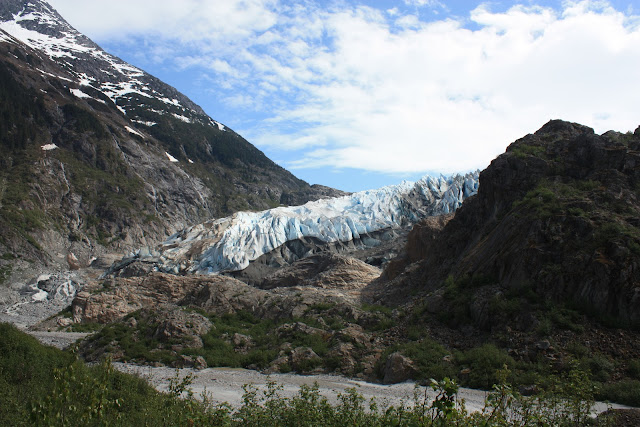The Juneau area has several rustic cabins available for overnight use by the public, which require a fee and reservation on www.recreation.gov. Some of these cabins are easier to access than others, but all of them are hike-in. A few weeks before Stephany arrived, I got online and searched for the availability of these cabins during the time that she'd be in Juneau. I found that the cabins are usually booked weeks (or sometimes, months) in advance, but I was able to reserve the John Muir Cabin for one night during mid-week.
The John Muir Cabin is accessed from the Spaulding Meadows Trailhead along the Glacier Highway, just west of Auke Bay. This trail forks after .8 miles, where you take a left on the Auke Nu Trail, which eventually ends at the John Muir Cabin.
Me and Stephany, at the Auke Nu Trail junction:
 After reaching the Auke Nu Trail, the landscape began to change from evergreen forest to muskeg (boggy, open areas with patches of stunted trees).
After reaching the Auke Nu Trail, the landscape began to change from evergreen forest to muskeg (boggy, open areas with patches of stunted trees).
Most of it looked something like this:

Stephany:
 Several of the trails that I hiked in Alaska were built with boards, especially in areas of muskeg. The wooden platforms kept your feet out of the mud, but they were also very slippery when wet. Almost everyone that I hiked with ate some dirt (or wood) at some point during the summer. Ouch!
Several of the trails that I hiked in Alaska were built with boards, especially in areas of muskeg. The wooden platforms kept your feet out of the mud, but they were also very slippery when wet. Almost everyone that I hiked with ate some dirt (or wood) at some point during the summer. Ouch!
The trail steadily ascended through muskeg, and soon, we knew we were nearing the cabin. Each time the trail disappeared over a hill in front of us, we thought for sure the cabin was just out of view, until we reached the top to find the trail continuing with no cabin in sight. It wasn't a steep or overly grueling trail, but 1500 feet of elevation gain in 3.5 miles was enough for a workout.
Finally, the cabin came into view - a welcome sight:
The views from the porch were really nice, and you could see into Auke Bay and the Gastineau Channel.
The cabin itself was pretty cool, too. It was built in 1980 to commemorate the 100th anniversary of John Muir exploring Southeast Alaska. I think it has been renovated in recent years because it looked very nice and new, both inside and out.
A look inside the cabin:
I wasn't expecting the spaciousness. The staircase led to an attic with more space for people to sleep, if necessary (there were also two bunks downstairs).
After setting our stuff down and having a look around the cabin, we went back outside to catch a glimpse of the sunset.
That night, we played cards with a deck we found in the cabin. We also made our own Boggle board in the cabin "sign in" notebook. Stephany is a Boggle master, but sometimes I beat her, even though she'll never admit it!
To this day, I wonder if anyone else staying there played Boggle with our board.
The next day, we had more plans, so we didn't stick around too long after waking up. We stopped to enjoy the views one more time before saying farewell to the cabin.
I was happy to show Stephany an awesome place while she was visiting, and there was still more to come. As long as you have the time, there should always be more adventure to come when you're in Alaska. It's a state that's best experienced by getting outside. Isn't that the point?
























